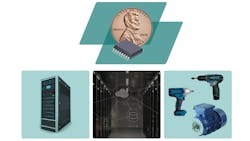High-Power Current Sensors Primed for Automotive, Industrial Power Apps
Check out our APEC 2023 digital magazine for more show coverage.
In its Booth #863 at APEC 2023, ACEINNA is unveiling its latest high-power current-sensing devices. The company’s MCx2101 (AEC-Q100 qualified automotive) and MCx1101 (industrial) isolated AMR current sensors are said to maximize the benefits of using SiC/GaN and help further increase the overall power-conversion efficiency while improving the safety thanks to their industry-leading high accuracy, high bandwidth, and fast response time.
The sensors are used in broad number of applications ranging from solar-panel inverters, wind turbines, data-center power supplies, motor drivers in industrial and on-board chargers and fast dc chargers, traction inverters and various power-supply and conversion applications in automotive use cases. In many such applications, silicon-carbide (SiC) and gallium-nitride (GaN) power transistors are replacing silicon MOSFETs. These new transistors are enabling higher-frequency systems with better efficiency and smaller size.
When developing power solutions using these higher frequencies, engineers require a higher-bandwidth current sensor for the current-control loop. Totem-pole power-factor correction (PFC) requires fast-switching ripple current measurements, as do motor and inverter applications. Higher-bandwidth sensors also enable fast step response in protection circuits.
The 1.5-MHz frequency response of ACEINNA’s current sensors enables SiC/GaN advantages such as higher frequency, smaller system size, and better system efficiency. Their benchmark step-response time (300 ns) minimizes protection timing budget for current sensors and enables the protection of higher-frequency SiC/GaN switches. Benchmark accuracy (0.6% typical) over temperature for ICs provides better control and regulation to improve efficiency and reliability. The sensors’ low offset and low noise provides high accuracy across the dynamic range.
Check out our APEC 2023 digital magazine for more show coverage.
About the Author
David Maliniak
Executive Editor, Microwaves & RF
I am Executive Editor of Microwaves & RF, an all-digital publication that broadly covers all aspects of wireless communications. More particularly, we're keeping a close eye on technologies in the consumer-oriented 5G, 6G, IoT, M2M, and V2X markets, in which much of the wireless market's growth will occur in this decade and beyond. I work with a great team of editors to provide engineers, developers, and technical managers with interesting and useful articles and videos on a regular basis. Check out our free newsletters to see the latest content.
You can send press releases for new products for possible coverage on the website. I am also interested in receiving contributed articles for publishing on our website. Use our contributor's packet, in which you'll find an article template and lots more useful information on how to properly prepare content for us, and send to me along with a signed release form.
About me:
In his long career in the B2B electronics-industry media, David Maliniak has held editorial roles as both generalist and specialist. As Components Editor and, later, as Editor in Chief of EE Product News, David gained breadth of experience in covering the industry at large. In serving as EDA/Test and Measurement Technology Editor at Electronic Design, he developed deep insight into those complex areas of technology. Most recently, David worked in technical marketing communications at Teledyne LeCroy, leaving to rejoin the EOEM B2B publishing world in January 2020. David earned a B.A. in journalism at New York University.

